VOL.52, NO. 2
Transpositions of James and the Giant Peach: Analyzing the Signification of the Orphan in Visual Imagery
Laura Cesa
INTRODUCTION
Originally published in 1961 and credited as Roald Dahl’s first novel written for children, James and the Giant Peach centers on James Henry Trotter, an orphan forced to live with his cruel aunts until something peculiar happens. A curiously large peach suddenly grows in the garden of his new home. James then goes on an unexpected transatlantic journey with a group of insects after discovering them inside the magical peach. The story of James has been republished and adapted into different forms since its conception. This article intends to focus on the transmission of information between the novel and the film adaptation of Road Dahl’s James and the Giant Peach (1961) with the depiction of the child in mind. How do the illustrations and filmic imagery affect the depiction of the child in these cases?
Roman Jakobson in “On Linguistic Aspects of Translation” coined the term “intersemiotic translation” to describe the “interpretation of verbal signs” using “signs of nonverbal sign systems” (127). Although Jakobson does not infer further meaning, it has been accepted to mean the transposition of verbal signs into other avenues of nonverbal signification, such as literary texts into illustrated form or cinematic adaptations. This definition can include various intermedia translations, this article will focus on the following pairs: text to illustrations and book to film. There is a correlation between translation studies and adaptation, in which both reproduce the original text following their respective procedures that “will affect the final product” accordingly (Echauri Galván 62). However, there is a technical difference in the process of adapting or translating media that distinguishes them. In simple terms, translation often refers to the process of converting linguistics with a focus on equivalence (Jakobson 127). Adaptation can refer to the transformation of source material through reinterpretation and recreation, with considerations made to audience reception (Hutcheon and O’Flynn 8–9). On account of the interdisciplinary nature of translation and adaptation and to avoid misunderstanding, this article will substitute the process of “translation” and “adaptation” for “transposition” to refer to the visual focus. Thus, there will be a focus on the semiotic systems of transposition between word and illustrative depictions by both Nancy Ekholm Burkert and Quentin Blake, and between the book and the 1996 film adaptation.
The visual identity of Dahl’s work is often linked to Blake’s illustrations. Blake and Dahl’s first collaboration, The Enormous Crocodile (1978), birthed an illustrious partnership that has outlived Dahl himself. After Dahl died in 1990, Blake posthumously re-illustrated many of Dahl’s earlier works. This success cemented Blake’s images as the visual correlation of Dahl. However, before there was Blake, James was originally illustrated by Burkert. The film adaption of James, directed by Henry Selick and produced by Tim Burton and Denise Di Novi, utilizes live-action and stop-motion animation to depict the journey of James’s growth in a different way. This article will broaden the research scope by analyzing the transposition between the literary and visual story of James, and the subsequent depictions of neglect and growth.
METHODOLOGY
Through the prism of translation and adaptation studies, this article intends to visually analyze scenes that are significant in establishing or developing the character of James. The difference in artist interpretations provides an incentive to analyze the different transpositions of the text. The analysis will consider the artistic decisions made to include and transmit certain visual codes and the relationship with reader response. To fit the conventions of this research, illustrations that were identified as depicting irrelevant information were excluded. In other words, there will be a direct focus on depictions of significance (such as characterization or worldbuilding visuals) which reveal a unique depiction of the child from the source text. Due to the discrepancy of color between the film adaptation and literary illustrations, there will be an exclusion of color theory when conducting the visual analysis.
In short, illustrations and visuals from the film will be identified as significant in terms of their depictions of James and his development. This article has the following three interrelated objectives: to analyze the construction of James in various forms, to identify the depiction of his neglect and growth and finally, to consider the transposition implications.
INEVITABILITY OF GROWTH AND CHILD DEVELOPMENT
What is meant by growth? In child development studies, growth encapsulates the journey of “perceptual, emotional, intellectual, and behavioral capabilities” (“Child Development”) that has been theorized by, among others, Jean Piaget (1936, 1945, 1957), Lev Vygotsky (1978), John Bowlby (1953, 1956, 1988), Mary Ainsworth (1964, 1970), Sigmund Freud (1905, 1938), Lawrence Kohlberg (1984). The purpose of this article is to use child development studies to support the visual analysis of growth. It is accepted that, regardless of socio-cultural contexts, universal psychological processes occur during childhood. Freud’s research includes psychoanalytic theory and the development of attachment between child and caregiver. Freud (1938) proposed that this attachment is derived from the child’s instinctual needs and the mother’s role as the provider of food. Correspondingly, Ainsworth built upon Bowlby’s research on a child’s attachment to their parents, with both theorists noting the importance of a mother-baby bond and the cognitive effects of separation. With this in mind, it is interesting to consider the absence of James’s parents and how his role as a neglected orphan has been visually depicted in his childhood development.
LOSS AND THE ORPHAN
The archetypal trope of the orphan creates a narrative that can situate readers between revisiting childhood developmental anxieties and wanting the conventional familial resolution. The readers are introduced to four-year-old James who “lived peacefully with his mother and father in a beautiful house beside the sea” (7 [1973]) in an idealistic family-centered social order. When this is stripped away, it exposes the “psycho-developmental stages” such as, but not limited to, trauma, separation anxiety and regression (Curtis 358). The parents are never physically described by Dahl. Burkert and Blake also omit James’s parents from their illustrations. The film adaptation, however, features his parents in the opening sequence with a prelude that differs from the source material. The film’s opening scene establishes a strong loving bond between James and his parents and provides the grounding for the various changes made from the source material. Viewers watch the family dream of their future together while pointing out the cloud that resembles the Empire State Building. James does not initially see the resemblance, so his mother advises him to “try looking at it another way.” This scene foreshadows not only what is to come but also provides James with a sentimental memory and emotional connection to New York. The mother’s advice becomes the catalyst for James to face his fears and overcome his trauma. This contrasts greatly with the novel’s ending in which James has no direct confrontation with his past trauma. The film’s opening sequence begins to pivot into a nightmare exposition that explains the death of James’s parents, before cutting to James abruptly waking up in terror. These scenes expand on Dahl’s introduction and, as a result, may create a more prominent loss and emphatic response in viewers. By situating a happy James with his loving parents, viewers are likely able to form a “physical and psychological bond” with the family unit as a whole (Curtis 359).
Dahl does not go into detail about the “terrible thing” that happened with the “enormous angry rhinoceros” that led to the parents’ death (7 [1973]). Neither Burkert nor Blake choose to interpret the text and visually fill in the gap. Dahl ironically writes, “Now this, as you can well imagine, was a rather nasty experience for two such gentle parents” (7 [1973]), which is exactly what the readers are left to do. The readers are left to imagine the events that preceded the parents’ death. In Act of Reading, Wolfgang Iser argues that intentional gaps can be a beneficial narrative tool because readers are provoked into the production of textual interpretation and reading (Iser 165-69). Dahl’s choice to omit further details of the death is endorsed by Burkert and Blake by not filling in “the blanks and the negations arising out of the text” (Iser 169-70). The power between text and reader shifts and so does “the process of the interaction” (Iser 169-70). Applying Iser’s theory of reader response to illustrations, the choice to not illustrate could be inferred as a stimulant for readers’ textual meaning. With no textual or visual cues, the extent of the horror behind the tragedy is left to the reader to envision. This gap allows the implied child readers to envision the trauma in a capacity that maintains “childhood as a safe place” (Curtis 357). Adult readers, however, could fill in the gap differently and may project “adult anxieties” of loss (Curtis 357). The film adapts the scene of the parents’ death by showing the Empire State Building cloud transforming into a scary rhinoceros-shaped storm cloud. The familial hope has been consumed by the manifestation of James’s fear and grief - a rhinoceros. The death of James’s parents could also be described as a dark cloud that hangs over him, so the rhinoceros storm works as a repeated metaphor that pursues James as he grows. This ultimately sets up the narrative climax of James confronting the rhinoceros — the embodiment of his fears.
After the death of James’s parents by a rhinoceros, he is forced to go live with his Aunt Sponge and Aunt Spiker. Under this new guardianship, James is unhappy and endures verbal and implied physical abuse. Burkert does not depict these instances explicitly in her illustrations. Instead, she depicts James’s emotional change in the displacement process. In contrast to the film adaptation’s establishing shot of the seaside house and the family dynamic, Burkert translates Dahl’s text and provides an interior perspective. As seen in Figure 1; the seashells, beach bucket and little sailboat accompanying the ocean view from the window provide the context instead. James is also seen wearing a traditional sailor boy uniform, as evident by the subtle nautical line design on the sleeves and collar. This contrasts greatly with the image of James in a dark dilapidated room (see Figure 2) devoid of ornamental pleasures and a barred window with no serene view of the sea. The depiction of the emotional trauma and loss of attachment is apparent when comparing Burkert’s linework in the before and after illustrations of the parents’ death. As a fundamental element of art, William Moebius notes “a character’s experience may be represented by the thickness or thinness … smoothness or jaggedness … sheer number or profusion or by their sparseness, and by whether they run parallel to each other or at sharp angles” (Moebius 151). In Figure 1, the focal point is James while the background is composed of soft and clean lines that appear to be very deliberate in their parallel and perpendicular arrangement. This design may evoke a “comfortable stasis” in the readers because the orderly appearance conveys a “settled, orderly world” that is analogous to James’s life with his parents (Moebius 151). By contrast, after James is uprooted to live with his Aunts (see Figure 2) the linework contrasts significantly to represent his new “troubled emotions” and “endangered life” (Moebius 151). The disorderly sharp woodwork, contorted window bars, tussled hair and damaged clothing render a distressing scene that is full of nervous energy, on account of the abundance of capillary-like lines. The abundance of harsh linework in Figure 2 seems to evoke an agitated composition compared to Figure 1’s fewer and softer lines. There is, however, an exclusion of one notable line in Figure 2 – the horizon. The visual analysis of the horizon is important in the construction and depiction of James’s solitude and longing. In Figure 1, James appears in front of a structured window that frames the horizon and clear sky, with an upturned lip which contextually signifies a smile. We can infer from this that James appears to be happy. In Figure 2, James appears in a darker room in front of an angled and barred window that only shows a rainy sky. This depiction of James has a downturned lip from which we can infer that he is unhappy. The removal of the horizon in the latter’s scene “is likely to spell danger or trouble” according to Moebius (149). James is no longer rendered in a space with depth and the spatial design of the scene loses a form of perspective which can be comparable to James’s loss of perspective. James’s outlook on his future was bright like the clear sky before but the trauma of his loss and life with his abusive Aunts has now given him a bleak outlook.

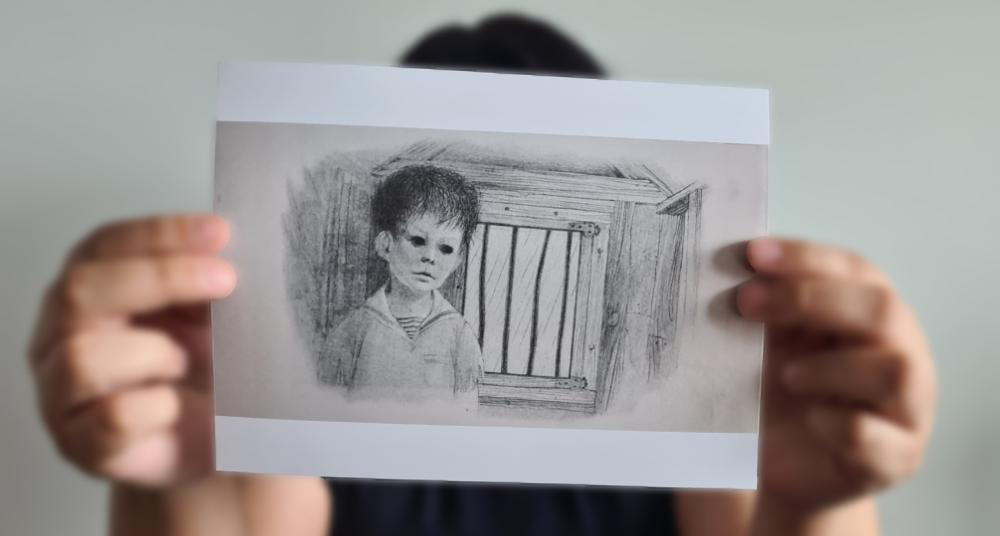
The character of the orphan can be used to portray the “manifestation of loneliness” (Kimball 559). The lack of familial ties and a secure home means that the archetype can also be used as a novelistic tool to represent endless possibilities. In other words, the character of the orphan has the “possibility … to reinvent themselves” (Kimball 559). The representation of James by Blake reinforces this depiction. In Figure 3 the composition shows James behind a fence with a neutral expression. However, by contextualizing the scene using Dahl’s text, we can infer that the expression is melancholic. This is reinforced by the point of his gaze and the positioning of his figure. Moebius highlights in “Introduction to Picturebooks Codes” the importance of positioning (Moebius 148). James is depicted alone, small in stature, and behind a fencing structure. The fence can evoke a sense of entrapment and solitude. James is positioned on the left side which could suggest the character is in a “secure, albeit potentially confined space” (Moebius 149). However, the text states that James is “gazing wistfully at the lovely but forbidden world” (11 [2007]). Blake illustrates this in Figure 3 by having James face towards the right side which tends to signify the movement “into a situation of risk or adventure” (Moebius 149). This depiction of the child underlines the symbolic nature of the orphan trope. They are an exemplar of hope that even after essentially losing everything, in this context a familial unit, there is still a future ahead. James wonders towards the white space of the image, an empty but unwritten future, a clean slate in which his development will begin anew. As established by Ainsworth’s (1970) and Bowlby’s (1956) research, cognitive development is affected by attachment relationships traditionally formed with the parents, particularly with the mother. The importance of a healthy family unit (whether biological or chosen) and the forming of secure attachments is exemplified by James’s relationships with his Aunts and with the insects.
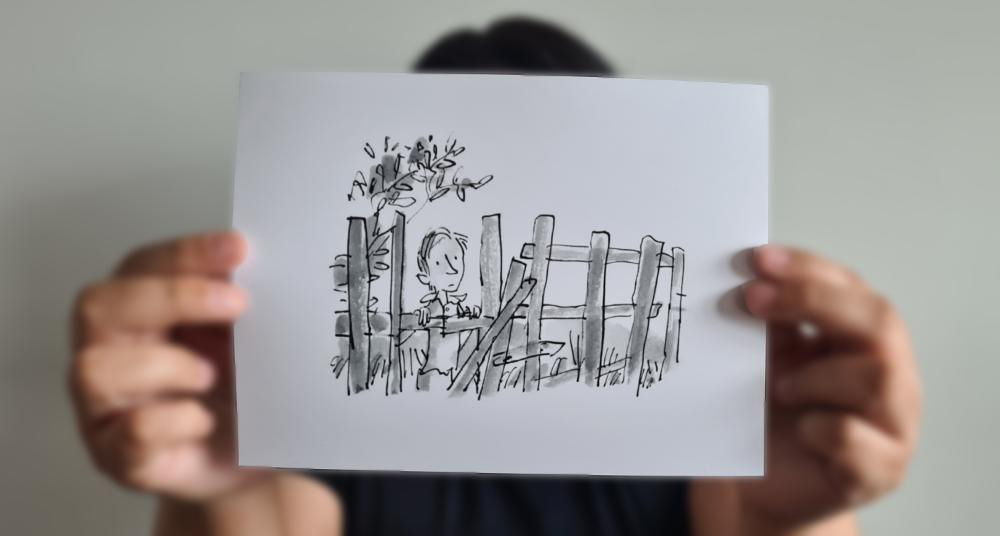
REGRESSION AND TRANSFORMATION
James’s distant relationship with his surrogate caregivers, Aunts Spiker and Sponge, is demonstrated in the introduction Burkert illustrated (see Figure 4). Burkert translates “ramshackle house on the top of a high hill in the south of England” (8 [1973]) in her depiction. The environment surrounding the house is very British English in design, featuring forms of field systems and flora regularly found in the English countryside. The text also states that James “could see the ocean itself … like a line of ink” which is translated as a distinct line in the horizon (8 [1973]). The ontological breakdown of this image creates a dynamic that communicates the essence of James. The clear division with the horizon breaks up the busy detailed landscape. The large fence that frames the foreground adds a sense of depth and illustrates the home as an enclosed space. The sense of confinement with the large fencing and the clear open sky can elicit a suspenseful feeling. The positioning of the scene subverts the role of the reader and directs their gaze to the white space, placing them in a similar position to James in Figure 3 where space stimulates the question “what lies ‘beyond’?” (Moebius 149). Bringing focus to the foreground, Burkert features three figures – James, Aunt Sponge and Aunt Spiker – with the dormant peach tree separating them. The importance of the tree is confirmed by its large and centralized position, whereas James appears in the bottom left as a small figure facing towards the horizon. This composition depicts the newly orphaned James as possessing “fewer advantages” than his Aunts who are positioned on the page at a higher stature (Moebius 146). The low composition of James could also be read metaphorically as “a signal of low spirits … of unfavorable social status” (Moebius 146). This visual further reinforces the textual code “they lived – Aunt Sponge, Aunt Spiker, and now James as well” (8 [1973]) which alludes to the unwelcoming and distant attitude the Aunts have towards James. James’s growth begins with him exerting his agency to journey into the peach – a representation of a maternal bond – and leave behind his Aunts’ who failed him as maternal surrogates.
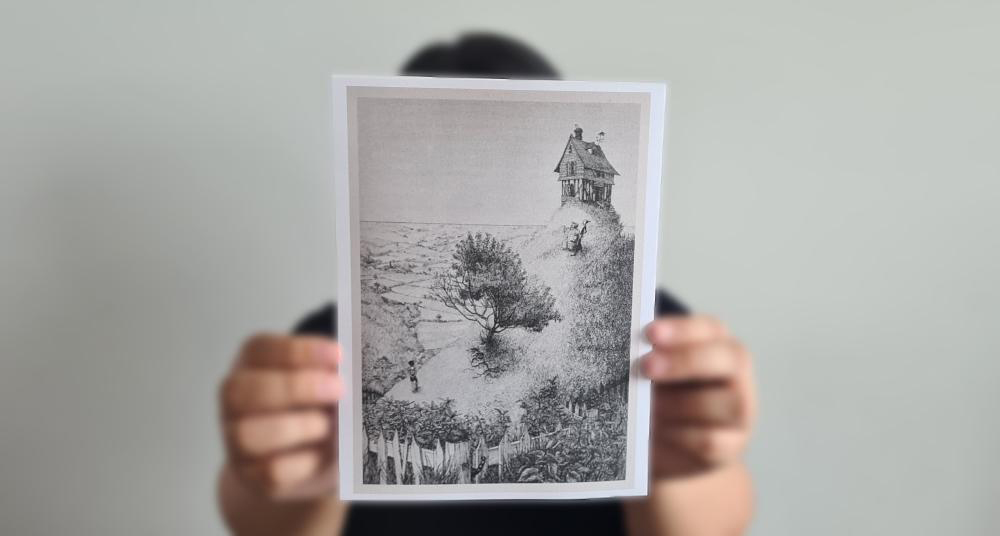
After receiving a small bag from a mysterious man, James falls and the bag of crocodile tongues embed themselves into the soil – activating the tree to birth the growing peach. This moment has been interpreted by many as evoking fertilization and birth imagery. Eve Tal likens it to a form of “magical regeneration” that draws parallels to the fertilization process (Tal 268-269). Tal highlights that in many East Asian traditions’ peaches are symbolically linked with female fertility (Tal 268-269). Furthermore, as noted by Trites (2014), the words “maturation” and “growth” originate from agricultural language. Derived from the Latin words maturare and Middle Dutch’s groeyen or groyen, meaning “to ripen, finish in good time” and “to manifest vigorous life, to put forth foliage, flourish” (Mature and Grow, as cited in Trites 3). By encountering this ripe peach that has brought life back to the dormant tree, James is presented with the metaphorical “return to a childhood psychological dilemma” of “maternal separation … the anxiety of such a separation” (Curtis 359). James proceeds to crawl into the peach which Mark West describes as a reversed “birthing process” on account of James entering head-first into the embodiment of a maternal experience (West 221).
Child development milestones differ on what is the earliest stage of development, but it is argued that children begin to use their senses in the moments leading up to and following their birth. Burkert does not illustrate the birth of the peach nor the moment James enters it. Blake also makes the same artistic choice, albeit he draws attention to the scene of James in the tunnel about to enter the pit (see Figure 5). The composition is similar in design to Figure 3 by placing James on the left side but moving towards the right side, signifying the beginning of his “adventure” away from his “confined” life with his Aunts (Moebius 149). The text differentiates between the tunnel walls and the pit by its material properties, with James identifying the pit door as “jagged” wood abundant in “deep grooves” (28 [1973]). This distinction is omitted in Blake’s rendering. Instead, he paraphrases the text to suit his loose illustrative style which is cautious of a distracting and detailed background. Using light, he creates and directs all focus on what is behind the door which can also symbolize James’s brighter future.
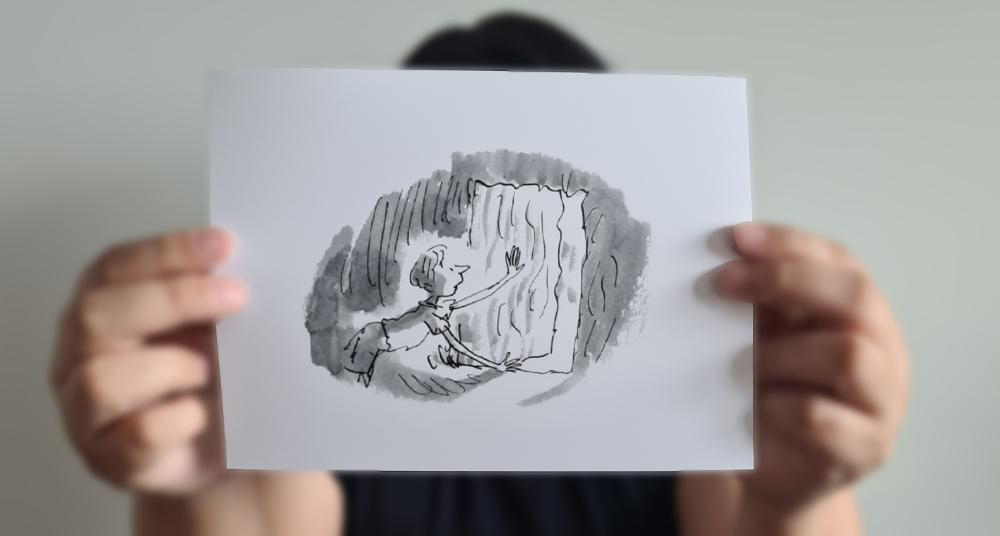
Selick’s transposition of the source material does not follow the codes of position but instead depicts James moving backwards (see Figures 6-7 ) instead. This positioning could, as Curtis states, denote the “maturational backsliding” of regression that “occurs along the developmental path to normal adolescence” (Curtis 361). James is physically framed as moving backwards but symbolically this regression is a healthy one in child development. The film also features an additional facet, that is otherwise unobtainable in the literary text. Through the medium of moving images, James combines live-action and stop-motion animation to enhance the fantasy element. This hybrid cinematography can visually depict James’s journey and transformation distinctly. In this portrayal, the film uses cinematic style as a narrative tool. By paraphrasing the passage where James enters the peach, the transition to the animation is incorporated in a coherent manner that facilitates the magical properties of the peach. Selick’s depiction of the tunnel sequence also further reinforces the previously mentioned birth and fertilization imagery. The text’s description of “the tunnel was damp and murky … the floor was soggy … the walls were wet and sticky” (28 [1973]) is transposed in the film as looking like a muscular tube made from glistening material (see Figures 6-7 ). Both Dahl’s text and the film adaptation depiction elicit the likeness of a birth canal. The film adaptation of this sequence is more explicit in its transposition of the source material. The starker resemblance to the fallopian tube, along with the use of lighting to evoke imagery of ultrasounds, exemplifies the birth imagery more compared to Blake’s illustration (see Figure 5 ). While regressing to the “state of oneness with the mother-figure” inside the peach, James creates a familial bond with the insects (Curtis 362). This directional choice by Selick can be understood as metaphorical, both as the rebirthing or regression of James and his rebirth from live-action to a stop-motion animated character.
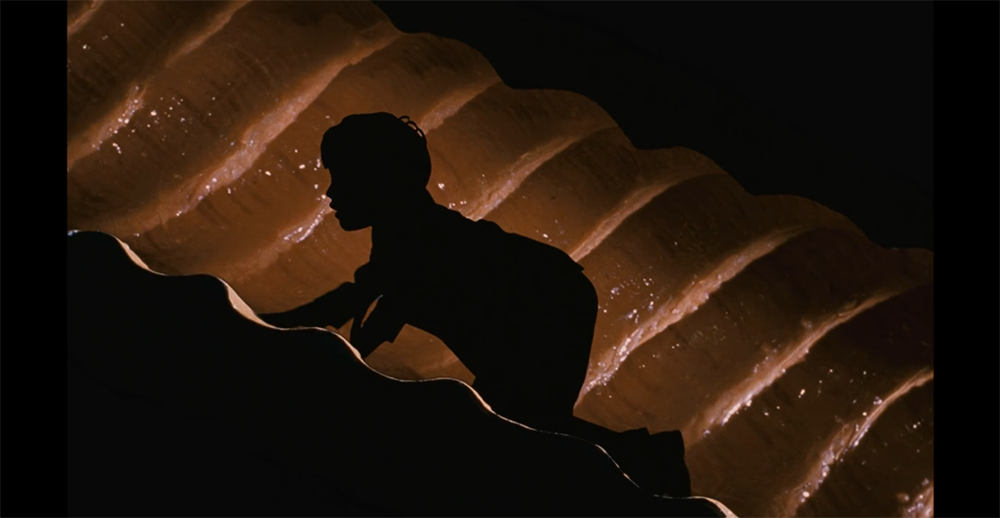

The familial bond between James and the insects is present in the book, however, in the film Miss Spider is depicted as more maternal. This characterization is best represented in the bedtime scene (see Figure 8 ) where James and Miss Spider connect and reconcile a bond likened to parent and child. It is interesting to note that Selick also directed Coraline (2009), which also features imagery with mothers and spiders. The protagonist Coraline crawls into a parallel world with a “bad” mother as a counterpart to her real “good” one. During one scene, the “bad” mother transforms into a spider and pursues Coraline to capture her in her web by using “love, attention, and … food to lure Coraline” (Herndon 5). Although the intent of that tale is malicious, parallels can be drawn in reverse with James and Miss Spider. James is lured by the peach after eating its flesh and receives a bounty of love and attention from the insects. James develops a familial bond with Miss Spider and the web she creates is not a trap as it is in Coraline¸ but rather a place of respite for James.
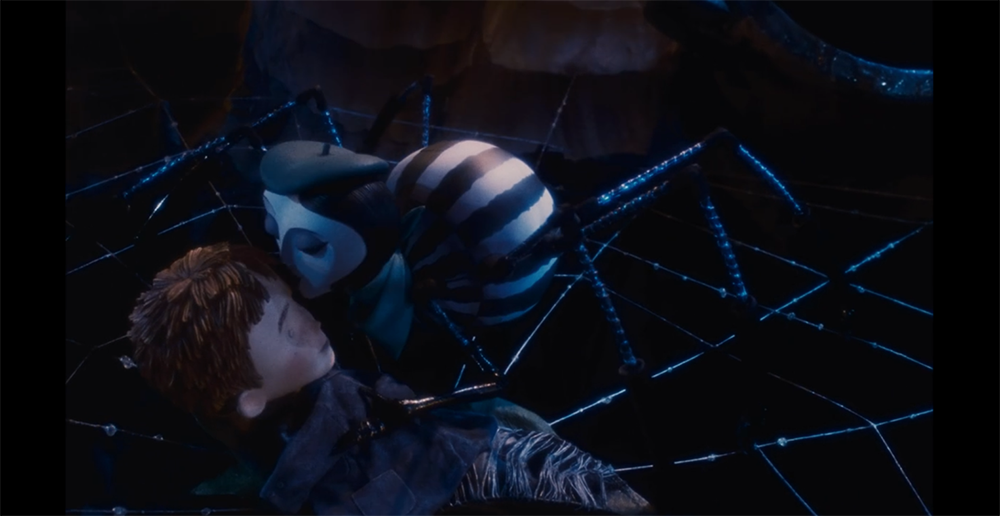
As noted by Maria Nikolajeva and Liz Taylor, beds are significant cultural signifiers and a place of “power struggle between child and adult … self and the world, private and public” due to their prominence as a child’s closest surroundings following birth (Nikolajeva and Taylor 145). Like the tunnel sequence, the imagery of the womb correlates to the connection of beds evoking imagery “of the life cycle, including child-birth, procreation and death” (Nikolajeva and Taylor 154). The duality of symbolism incites two opposing emotions: beds can be a place of security or anxiety. Furthermore, beds can also signify the “transitional process of separation” for children from adults (Chou 19). James unloads his worries on Miss Spider and ruminates over “what if?” scenarios. This anxiety stems from his fear of being “alone for a long time” and exclaims “I’ll die if I have to go back to the way I was!”, in which Miss Spider responds: “Nobody can make you do anything James if you do not let them.” By assuming the parental role, Miss Spider exerts authority by putting James to bed while also soothing him about the “anxiety-inducing situation” of “physical separation and mandatory isolation” (Chou 29). Through the performance of the “goodnight kiss”, Miss Spider engages in the “transitional function” that helps “the child through the process of falling asleep and being separated from parents” (Chou 22). The bed can become a space where the child can exercise more agency as “dreams and nightmares bring forward our deepest and most secret emotions” (Nikolajeva and Taylor 158). In this state, the film changes visual style again to depict the move between life (live-action) and the fantastical (stop-motion animation) with a collaged sequence (see Figure 9 ). This sequence is a visual manifestation of James’s fears but with further interpretation. It could symbolize the period of gestation and transition within the peach that James is undergoing.
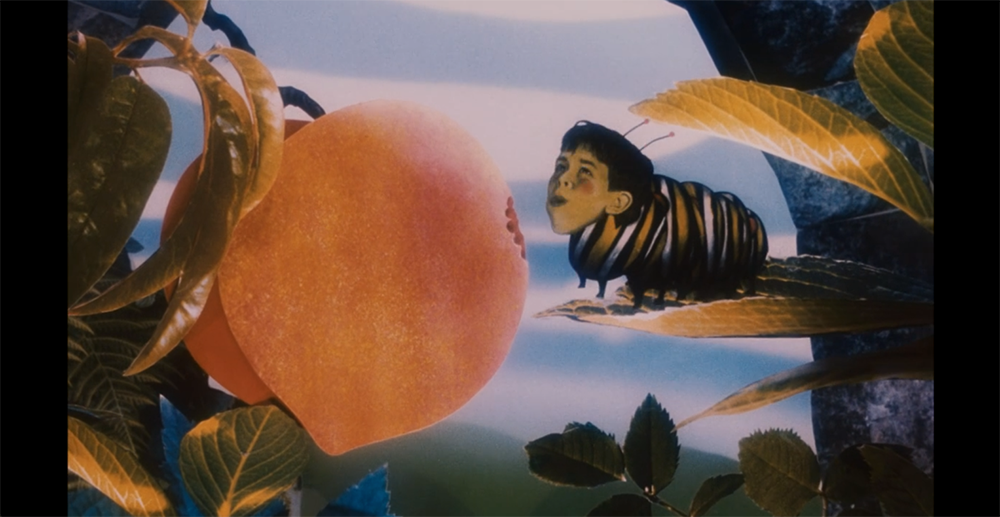
This scene did not appear in the book in any form. Selick is following the process of compensation loosely, by replacing the meaning of James transitioning into a mature young adult with a symbolic metaphor of a caterpillar. James the caterpillar is getting the nourishment he needs from the peach to become a butterfly and reach his full potential. This visual is analogous to the traditional maternal relationship and the “core of the child’s unconscious anxieties surrounding separation from the mother” in particular, the mother’s breastmilk, the “primary source of nourishment” for a child (Curtis 364). The peach is in itself a source of food for James but also a vehicle for him to “sublimate the primal anxieties surrounding maternal attachment” (Curtis 364). However, the dream once again transforms into a nightmare that reveals the Aunts are on his trail along with the rhinoceros storm. The fear of both these trauma-inducing catalysts catching up to him causes caterpillar James to run away from the peach, a source of growth and nourishment, and into hiding. This could symbolize that living in fear will hinder James’s development. This sequence also provides the narrative shift to show the viewer that the Aunts are alive and still hunting James.
A constant theme of James that becomes more visually prominent in the film is that James is living in fear and being consumed by it. Both text and visual depictions of James feature a structure of catastrophe and solution that forces James to demonstrate and develop his autonomy. James establishing a sense of “self-reliance” also diverts “potential anxieties that could arise from the reader’s confrontation with the orphan figure” (Curtis 366). The film deviates from the source material by paraphrasing and transforming certain action sequences. Although the film changes the shark into a mechanical beast and the cloudmen into a skeleton gang, it retains the suspense and intensity of the disasters in Dahl’s text. These scenes showcase James’s problem-solving ability and the love he has for his new insect friends. A powerful deviation in the film from the source material is the addition and depiction of James’s final confrontation with the manifestation of his fear - the rhinoceros that set the narrative of the book in motion and separated him from his parents.
James overcomes his anxieties and fears that have manifested from the separation from his parents by confronting the root of his psychological issue – the “terrible thing” with the rhinoceros (7 [1973]). In the transposition to film, as previously mentioned, the rhinoceros manifests itself as James’s personification of fear. The omission of the various obstacles, such as the Cloud-Men from the text, is compensated by the inclusion of the thunderous rhinoceros storm (see Figures 10-11 ) that haunts his dreams and thoughts throughout the film. It isn’t until this scene that the viewers fully understand what is truly haunting him, in which he exclaims “it got my mum and dad. It won’t get my friends.” During the confrontation, the emotional journey of James overcoming his obstacles reaches its climax. No longer running away from his fears, James stands his ground and starts shouting at the rhinoceros. This, however, does not necessarily achieve much. It isn’t until the insects reiterate what the mother said in the opening sequence: “Try looking at it another way!” that James looks fear in the eyes and shouts: “You’re not even a real rhino! … I’m not afraid of you!”. This exchange marks a milestone in James’s emotional development. By taking an authoritative stance to save himself and the insects, James has progressed to “an adult-normative state” (Curtis 365). James’s emotional growth is connected to his problem-solving ability that save the insects multiple times. When faced with danger, the roles are subverted and James takes up the parental role and establishes his sense of self. This development towards an aetonormative adult self runs parallel with his journey to resolve his separation anxiety by developing agency. This newfound adult role that James confidently takes up through his confrontation with the rhinoceros eliminates his “child status” which leaves the final hurdle for the orphan narrative trope – finding a solution to his “orphan status” (Curtis 367). This materializes after the peach falls from the sky onto New York City, where James and his surrogate insect family are reintegrated into society. Dahl has created a narrative in which, by regressing into the peach and transforming through the fantastical properties of the maternal environment, James overcomes the neglect and separation anxiety following his parents’ death. The dynamic with the insects changes, and the peach is no more, but James continues to exercise autonomy and agency by living happily in New York with “all the friends and playmates in the world” (152 [2007]).

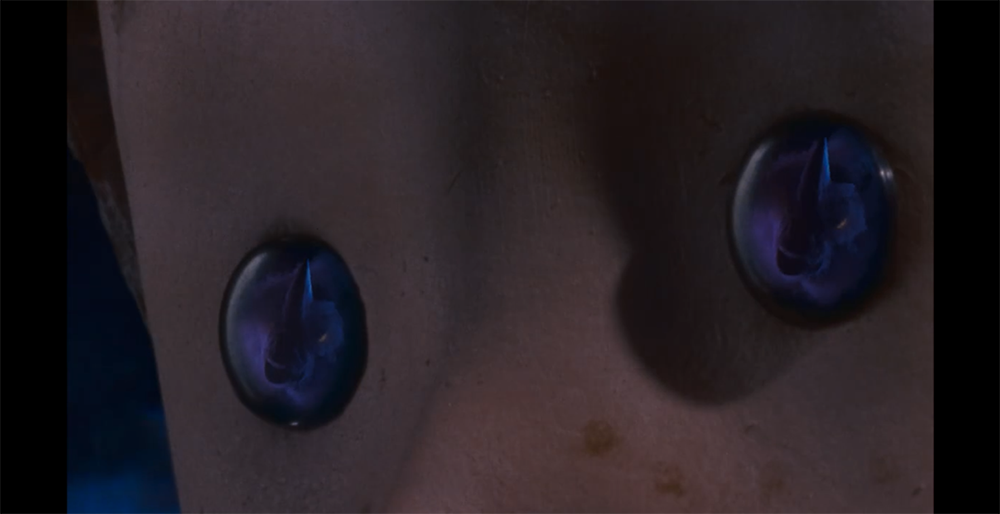
CONCLUSION
James and the Giant Peach is a story about transformation. The novel, like James Henry Trotter, has taken on many forms and styles. Bruno Echauri Galván concluded in his research that illustrative work in literature can teeter the edge of “existing between remaining faithful to an original work and the ineluctable necessity of transforming it” (Echauri Galván 63). By expanding Echauri Galván’s findings on the transposition of text and images, this analysis assists in illuminating the semblance of the translational process in adapting the depiction and development of James. This shared theoretical and practical understanding provides an incentive and grounding for further research.
The findings show a distinct difference in transposition techniques. Breaking down the choices of the illustrators and film production and their intentions, in the context of their mediums and style, allows research into the extent of the collaborative contribution to their respective portrayals of the construction of James. Burkert, Blake and the film’s depiction of James’s neglect and characterization as an orphan differ greatly and reveal unique perspectives on how James’s situation is perceived and understood. In Burkert’s work (1973) one can recognize the level of detail in each image and how they tend to “enhance” the text by paraphrasing to provide and expand the “meaning provided by the text” (Echauri Galván 64). Through Burkert’s use of lines, the traumatic separation anxiety and feeling of distance that the orphan undergoes is conveyed. Although the Aunts’ abusive behavior towards James’s is never explicitly described in the text or visualized by the artists, James is often depicted in a way that represents the different ways that abuse and trauma can manifest. Burkert uses composition to position James beneath the Aunts and as a small figure trapped within enclosed spaces with no horizon. The sense of realism in Burkert’s illustrations also conveys an unsettling effect when juxtaposed with the fantasy elements within the story. Alternatively, Blake depicts James often as a character in movement where he is positioned as journeying and looking towards the world beyond the page. Due to the minimal style of Blake, the sense of realism that Burkert depicted is lost. However, Blake’s technique of foregrounding the composition and omitting background details is instrumental in the lack of paraphrasing or reinterpreting the information. There is a sense of lightness and hope in Blake’s depictions of a child who has experienced abuse, while Burkert captures the gritty reality of the experience.
On the other hand, the 1996 film adaptation omits a lot to make room for the paraphrasing of the source text. The consequence of the paraphrasing and omissions could result in many gaps. However, Selick fills those gaps with visual metaphors that utilize composite cinematography. Similarly to Burkert’s depiction of the text, the live-action in the film is juxtaposed with the fantastical stop-motion animation to create an uncanny effect. By depicting James’s transatlantic journey on a peach in animation form, the film is able to visually depict the development of his sense of self in a distinct manner. Although the film reverts back to live-action in the end with the same actor, the character of James is no longer the same. After confronting the things that scared him the most with the support from his new chosen family, James has grown into a happier and more secure child.
Whether it is how they visually represent the same source text or what they choose to include and omit, each transposition of Dahl’s text reinforces the importance of secure and safe attachments and the dissonance that occurs from neglect. The visual depiction of James evokes a conscious regressing to confront the anxiety of an earlier childhood space where we, the viewers and readers, can follow James’s physical and emotional growth.
Works Cited
Ainsworth, Mary D. "Patterns of Attachment Behavior Shown by the Infant in Interaction with His Mother." Merrill-Palmer Quarterly of Behavior and Development, vol. 10, no. 1, 1964, pp. 51-58, https://go.exlibris.link/QwyXs2PR.
Ainsworth, Mary D. Salter and Silvia M. Bell. "5. Attachment, Exploration, and Separation: Illustrated by the Behavior of One-Year-Olds in a Strange Situation." The Life Cycle, Columbia University Press, 1981, pp. 57-71. https://doi.org/10.7312/stei93738
Blake, Quentin, illustrator. James and the Giant Peach. By Roald Dahl. Binaural Edition ed. [online] Penguin Books Ltd. 2007. Available at: https://books.apple.com/.gb/book/james-and-the-giant-peach/id374868964 [Accessed 2019].
Bowlby, John. Child Care and the Growth of Love. vol. A271, Penguin Books, 1953. vol. Book, Whole.
---. “Mother-child separation.” Mental Health and Infant Development, 1959. 1, 117-122.
---. “Attachment, communication, and the therapeutic process.” A Secure Base: Parent-child attachment and healthy human development. 1988. 137-157.
Burkert, Nancy Ekholm, illustrator. James and the Giant Peach. By Roald Dahl. Puffin Books. 1973
“Child Development.” Encyclopedia Britannica, The Editors of Encyclopedia, 7 May. 2022, https://www.britannica.com/science/child-development-process. Accessed 26 March 2023.
Chou, Wan-Hsiang. "Co-Sleeping and the Importation of Picture Books About Bedtime." Children's literature in education, vol. 40, no. 1, 2009, pp. 19-32, https://doi:10.1007/s10583-008-9074-8.
Curtis, James M. "In Absentia Parentis: Confronting the Uncanny Orphan in Roald Dahl’s James and the Giant Peach." Children's Literature Association Quarterly, vol. 40, no. 4, 2015, pp. 355-370, https://doi:10.1353/chq.2015.0052 .
Damon, W. and R. Montemayor. "Essays on Moral Development, Vol 2: The Psychology of Moral Development - the Nature and Validity of Moral Stages. Kohlberg, L." vol. 30, American Psychological Association, 1985, pp. 952-954. https://go.exlibris.link/nSBTcrGG .
Echauri Galvan, Bruno. "Translation Depends on the Artist Two Approaches to the Illustrations of James and the Giant Peach through the Prism of Intersemiotic Translation." Babel (Frankfurt), vol. 65, no. 1, 2019, pp. 61-80, https://doi:10.1075/babel.00074.ech .
Freud, Sigmund. Three Essays on the Theory of Sexuality. Standard Edition 1905. 7: 123- 246.
---. An Outline of psychoanalysis. London: Hogarth. 1938.
Herndon, K.E. “Food and Power in Roald Dahl’s James and the Giant Peach and Neil Gaiman’s Coraline.” MA Thesis. 2009. pp.1–30, 60–61.
Hutcheon, Linda, and Siobhan O'Flynn. A Theory of Adaptation. Routledge, New York, 2013, https://doi:10.4324/9780203095010.
Iser, Wolfgang. The Act of Reading: A Theory of Aesthetic Response. Routledge and Kegan Paul, 1978.
Jakobson, R. “On Linguistic Aspects of Translation”. In: L. Venuti, ed., The Translation Studies Reader. Oxon: Routledge, 2012, pp.126–132.
James and the Giant Peach. Directed by Henry Selick. Produced by Tim Burton and Denise Di Novi, Allied Filmmakers, 1996.
Kimball, M. A. "From Folktales to Fiction: Orphan Characters in Children's Literature." Library trends, vol. 47, no. 3, 1999, pp. 558-578, https://go.exlibris.link/Gj9dBnYS.
Kohlberg, L. The Psychology of Moral Development: The Nature and Validity of Moral Stages. Harper & Row, 1984. vol. v. 2.
Mary, D. Salter Ainsworth and Silvia M. Bell. "Attachment, Exploration, and Separation: Illustrated by the Behavior of One-Year-Olds in a Strange Situation." Child development, vol. 41, no. 1, 1970, pp. 49-67, https://doi:10.2307/1127388.
Moebius, William. "Introduction to Picturebook Codes." Word & image (London), vol. 2, no. 2, 1986, pp. 141-158, https://doi:10.1080/02666286.1986.10435598 .
Nikolajeva, Maria and Liz Taylor. ""Must We to Bed Indeed?" Beds as Cultural Signifiers in Picturebooks for Children." The new review of children's literature and librarianship, vol. 17, no. 2, 2011, pp. 144-163, https://doi:10.1080/13614541.2011.624940
Piaget, Jean. Play, Dreams and Imitation in Childhood. vol. 25;25.;87;87;, Routledge, 1999.
---. Origin of Intelligence in the Child. vol. vol 3, Routledge, 2013.
---. The Construction of Reality in the Child. Routledge, 2013. 1st
Tal, Eve. "Deconstructing the Peach: James and the Giant Peach as Post-Modern Fairy Tale." Journal of the Fantastic in the Arts, vol. 14, no. 2 (54), 2003, pp. 265-276, JSTOR, http://www.jstor.org/stable/43308629 .
Trites, Roberta Seelinger. Literary Conceptualizations of Growth: Metaphors and Cognition in Adolescent Literature. vol. 2.;2;, John Benjamins Publishing Company, 2014.
Venuti, Lawrence. The Translation Studies Reader. 3rd edition, Routledge, 2012.
Vygotskiĭ, L. S. et al. Mind in Society: The Development of Higher Psychological Processes. Harvard University Press, 1978.
West, Mark I. "Regression and Fragmentation of the Self in James and the Giant Peach." Children's literature in education, vol. 16, no. 4, 1985, p. 219, https://doi:10.1007/BF01139665 .